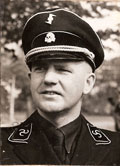Henk Feldmeijer

Johannes Hendrik (Henk) Feldmeijer was only 29 years old when the German occupational regime in the Netherlands appointed him ‘Foreman’ of the Dutch SS. As such, he was one of Heinrich Himmler’s most valuable pawns in Holland.
Eight years earlier, Feldmeijer decided to quit his studies of mathematics and physics at the University of Groningen and dedicate all his time and afford to national-socialism. Having thus minimized his options, he soon found himself at the most radical wing of the National-Socialist Movement (NSB) in the Netherlands. His radicalism eventually lead to a clash with the leader of the NSB, Anton Mussert. Feldmeijer was banned to the province, but in 1939 made a come-back into the party’s inner circle by establishing a new militia that was modelled after the German SS, called the ‘Mussert-Garde’.
Early May 1940, Feldmeijer was arrested and, together with twenty other politically suspect figures, locked away in a fort. A few days later, the German army invaded Holland and they were taken to France. After a nerve racking trip to Calais, Feldmeijer was freed by the Wehrmacht. He returned to the Netherlands and immediately was appointed leader of the Dutch SS.
As chief advocate of the pan-Germanic ideology of the SS, Feldmeijer soon found himself in deep conflict with Mussert, which lasted for five years. In the meanwhile, due to Hitler’s military adventures in the East, Feldmeijer had to turn his political SS-organization more and more into a reservoir for the Waffen-SS. He himself went to serve at the front twice, in Greece and the Sovjet-Union.
Returning to the Netherlands, Feldmeijer brought his front mentality and methods with him. He established a ‘Sonderkommando-Feldmeijer’ that would carry out the so-called ‘Silbertanne Aktion’, in which innocent citizens where murdered as reprisals for attempts at the lives of Dutch national-socialists by resistance groups.
Feldmeijer genuinely and unconditionally believed in the ideals of the SS. Nonetheless, he frequently put the patience of Reichsführer-SS Himmler to the test by giving in to financial, alcoholic and sexual temptations. His once devoted adherents also were more and more disappointed by Feldmeijer’s personal conduct and private life. At the same time, he tried to be a loving husband and father.
After Stalingrad and D-Day, Feldmeijer was increasingly obsessed by the approaching end game. Unlike most Dutch national-socialists, he didn’t speak idly when he stated that together with the German Nazis he wanted to gain victory or perish. February 1945, while rushing to the front at the Meuse, his car was attacked by an American fighter plane. Feldmeijer died and became what he wanted to be: a martyr.
Historian and journalist Bas Kromhout (1975) to find out why a bright student, who was brought up in a safe middle-class environment, turned out to be a hate monger, a terrorist leader and an accomplice of evil. Referring to social-psychiatrist Fathali Moghaddam’s five-storey building model, the life of Feldmeijer is evaluated as an example of radicalization.
Bas Kromhout received his PhD on this biography De Voorman. Henk Feldmeijer en de Nederlandse SS on 4 June 2012. The second edition has been published by publishing house Contact.
Email: baskromhout hotmail.com
Review NRC Handelsblad 9 June 2012
Review Dagblad van het Noorden 9 June 2012
Review De Groene Amsterdammer 28 June 2012
Review Vrij Nederland 30 June 2012
Review de Volkskrant 7 July 2012
| Last modified: | 25 September 2014 11.32 a.m. |
